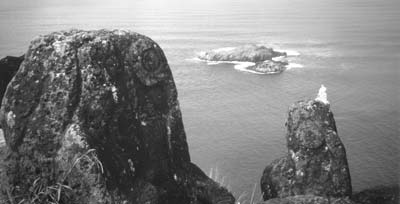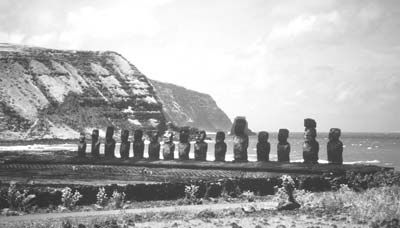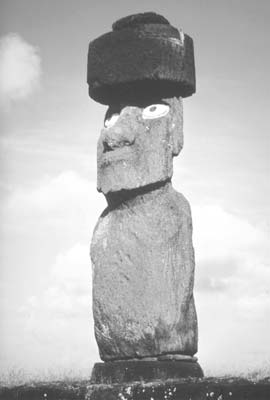Easter Island — where ancient mystery meets rugged natural beauty
by Thomas McKenna, Montpelier, VT
Easter Island, or Rapa Nui as it is known to locals, is the most remote inhabited place on Earth. Located about 2,200 miles from the coast of South America, its nearest neighbors are on Pitcairn Island about 1,300 miles to the west. Some travelers might consider the remote location reason enough to visit, but the main attraction is the large, mysterious human figures carved from stone centuries ago.
Where the first islanders came from, why they carved the giant statues, how they moved them into place, why they toppled them during tribal wars and why their civilization collapsed have been the subjects of much debate, scientific and otherwise. Whatever the answer, Easter Island will not disappoint you.
Island attractions
Many books have been published and many TV programs broadcast about the island and its statues, but it’s one of those rare places that, when you actually see it, turns out to be better than expected.
The large statues, or moai, sit on (or are toppled near) ahu, sacred ceremonial stone platforms. Out of respect, visitors should not step on the ahu or touch the moai. Several weeks before my visit, a Japanese tourist carved some graffiti into a fallen moai. He was sentenced to a week in jail and a $3,000 fine. I think he got off light.
Unlike the desert islands of the Galápagos, Easter Island is mostly a lush, green place with rolling hills, small, scattered forests, grassy pastures and farm fields. Sparsely vegetated fields of lava rock make up part of the island, but even those areas have a wild, natural beauty. There are groves of eucalyptus (imported from Australia) and even some swaying palms.
Along the coast there are dramatic vistas, with the Pacific waves breaking over the rocky shore and a few sandy beaches. (The locals do a lot of surfing.)
Despite the many attractions of Easter Island, it is not overcrowded with tourists, even during the high season in January and February.
Hanga Roa
About 4,000 people live on the island, virtually all of them in the only town, Hanga Roa. It’s a small-scale place, a village of one-story buildings and friendly, honest, pleasant, laid-back people. There is no trash along the roads and almost no graffiti.
Unlike at many famous tourist destinations, there are no hoards of urchins trying to sell you something — or steal your watch. You don’t have to run a gauntlet of hawkers and tacky souvenir shops between each parking area and the moai. In fact, you may see more horses and cows than tourists around them. It’s beautifully rural and unspoiled.
Seeing the sights
If you have the time, this fascinating tropical island is worth a week’s stay. However, all the major sites with moai can be visited during one full day plus two half-day tours. A rental car on the third day will allow you to move at your own pace and to revisit the places where you want to take more or better photos or just absorb more of the atmosphere.
In fact, you should consider renting a car and sightseeing entirely on your own, without a guide. You would save the cost of tours and tips and avoid the late starts and time wasted picking up and dropping off other tourists at their hotels.
I rented a hardtop Suzuki jeep for about $50 a day. It was delivered to, and picked up from, my hotel. (I booked the rental through my hotel, the Hotel Otai.) There was no written contract or mention of collision damage or insurance. They didn’t even ask to see my driver’s license. (This is Polynesia.)
Try to get your car in the evening so you can depart right after breakfast the next morning when it’s cool and calm. You can also drive out to see the sunrise or sunset over the Pacific.
Outside Hanga Roa, most of the roads are unpaved. I found only light traffic in the town and even less in the countryside. The biggest driving hazards were free-range horses, cows and chickens.
Finding your way
Being your own guide will require taking good books and buying a map. Maps may be available on the island, but books are scarce and extremely expensive. There are directional signs to the sites with moai, but you should find a map that shows their locations as well as area roads.
You will need to carry at least one basic guidebook, such as the Lonely Planet guide “Chile and Easter Island.” Other books about Easter Island can be found at your library, in local bookstores and online. It’s a good idea to copy only the book pages you want to take with you rather than carrying heavy books.
A good overall map of Chile is hard to find. Online, I bought a used Lonely Planet “Chile Travel Atlas” that included Easter Island.
Take your best shot
Good photographs of the moai are the main goal of most travelers to Easter Island. Some film is available there, but you would be wise to take more than you expect to use.
Almost all moai are along the coast, but all of them face inland. So to catch the sun on the faces, you should visit the ones on the west and north coast in the morning and the ones on the south coast in the afternoon. However, the orientation of some moai can make photographs a challenge.
My favorite site was the quarry, where you really need to visit both in the early morning and in the afternoon to get the best shots from every angle — another reason to drive yourself.
Festival fun
The Semana de Rapa Nui, a festival of native dance, music and cultural events, is held each February. Most of the islanders, from babes in arms to their grandparents, seemed to be in the parade that started the festival.
There were floats, bands and dancers plus people riding horses. Many of the women wore grass skirts, but the typical costume for men and women was a thong — that’s all — and their bodies were heavily painted from head to foot. The music was smooth and pleasant, playing late into the night.
Accommodations and dining
I stayed in the Hotel Otai (P.O. Box 22; phone 56 32 100 250, fax 56 32 100 482 or e-mail otairapanui@ entelchile.net), described by Lonely Planet as “the bottom of the top-end places.” It was very pleasant, with lush, tropical landscaping, a swimming pool and free, intermittent Internet service, but there was no air-conditioning or fan. Some cooling would have been welcomed in midday. My single room was $75 with breakfast.
The Hotel Hotu Matua (Ave. Pont s/n; phone 32 100 242) is more upscale, but it is near the airport and a very long walk from town. Staying at the Otai, where I could easily walk around town, was a definite advantage. The post office was across the street and the waterfront was a couple blocks away.
There are a number of good restaurants in town. Some serve food almost all day, but Rapa Nui is on the Chilean meal schedule, with dinner served about 9 p.m.
My favorite was La Taverne du Pecheur (Caleta de Pescadores), an unpretentious-looking place on the waterfront. The owner claimed to have “the best restaurant in the Pacific.” For $18, I got a whole fish surrounded by fresh vegetables and fruit that was so beautifully presented it was worth a photo.
A few tips
Dollars were accepted everywhere on Easter Island, but you might get a better exchange rate by using Chilean pesos brought from a mainland ATM. There is one ATM in Hanga Roa, but a peso in the hand is worth two in the ATM that’s not working.
There were a lot of souvenir shops in Hanga Roa and there was a wide variance in the quality of workmanship in handmade items, so shop around before buying. There was also a crafts market across from the local church offering the wares of many different vendors. It was a good place to see what was available and to compare products and prices. The prices didn’t vary much, but the artists’ abilities did.
In February it gets into the low 80s around midday, so the whole town takes a siesta from about 1:30 to 4 or 5 every afternoon. The early mornings and evenings are just about perfect, and it cools down nicely at night.
I saw no evidence of television, so take plenty to read. And drink a lot of fluids.
The particulars
Only LanChile (phone 800/735-5526 or visit www.lanchile.com) flies to Isla de Pascua (the Chilean name). They fly twice a day but not every day. It’s an expensive ($700) 4½-hour flight from Santiago. (It may also be possible to get there from Tahiti.)
I would recommend a morning flight so you have the rest of the day to get settled and oriented and make final arrangements for your sightseeing and rental car.
Unless you are coming from the western Pacific, you will have to pass through Chile to get to Easter Island. Chile now charges $100 to enter and $26 to leave the country, and this must be paid in U.S. dollars.
Since Santiago is a 12½-hour flight from New York, travelers from the East Coast will probably need to spend a day in Santiago before and after going to Easter Island. I’d suggest spending a couple weeks in Chile to see the Lake District, Patagonia and even the desert. Santiago, Valparaiso and Viña del Mar are worth a couple days, but avoid Mondays in Santiago when all museums are closed.
Travel in Chile
The temperature charts in Lonely Planet’s guide provide an understanding of when it is hot, cold, rainy or dry. The problem is that Chile is a long country oriented north to south with a variety of climates, so if you visit the north, center and south — plus Easter Island — you will probably need to make some compromises. I chose early February, when it was summer in Patagonia.
Except for skiing, there is not much for a visitor to do there in July, when the temperature is barely above freezing.
There are many tour companies that can make arrangements for travel in Chile. After some research, I chose Tara Tours (6595 NW 36th St., Ste. 306, Miami, FL 33166; phone 800/327-0080 or visit www.taratours. com). We worked out the details entirely by e-mail, and I was very pleased with their service.
You can save about half the price by arranging your own optional day tours after arriving in Chile rather than booking them through a tour company in the U.S.
Flying LanChile, an excellent airline, to and from the U.S. will save you money as well as qualify you for discounts on their flights within Chile and to and from Easter Island. They are partners with American Airlines, so be certain your AAdvantage number is entered for each flight to get credit for the miles with American Airlines.
Was there anything I didn’t like about Easter Island? Well, the scooped ice cream was too soft and lacked true, strong flavors; the wrapped Nestlé Mega ice cream bars were better.




